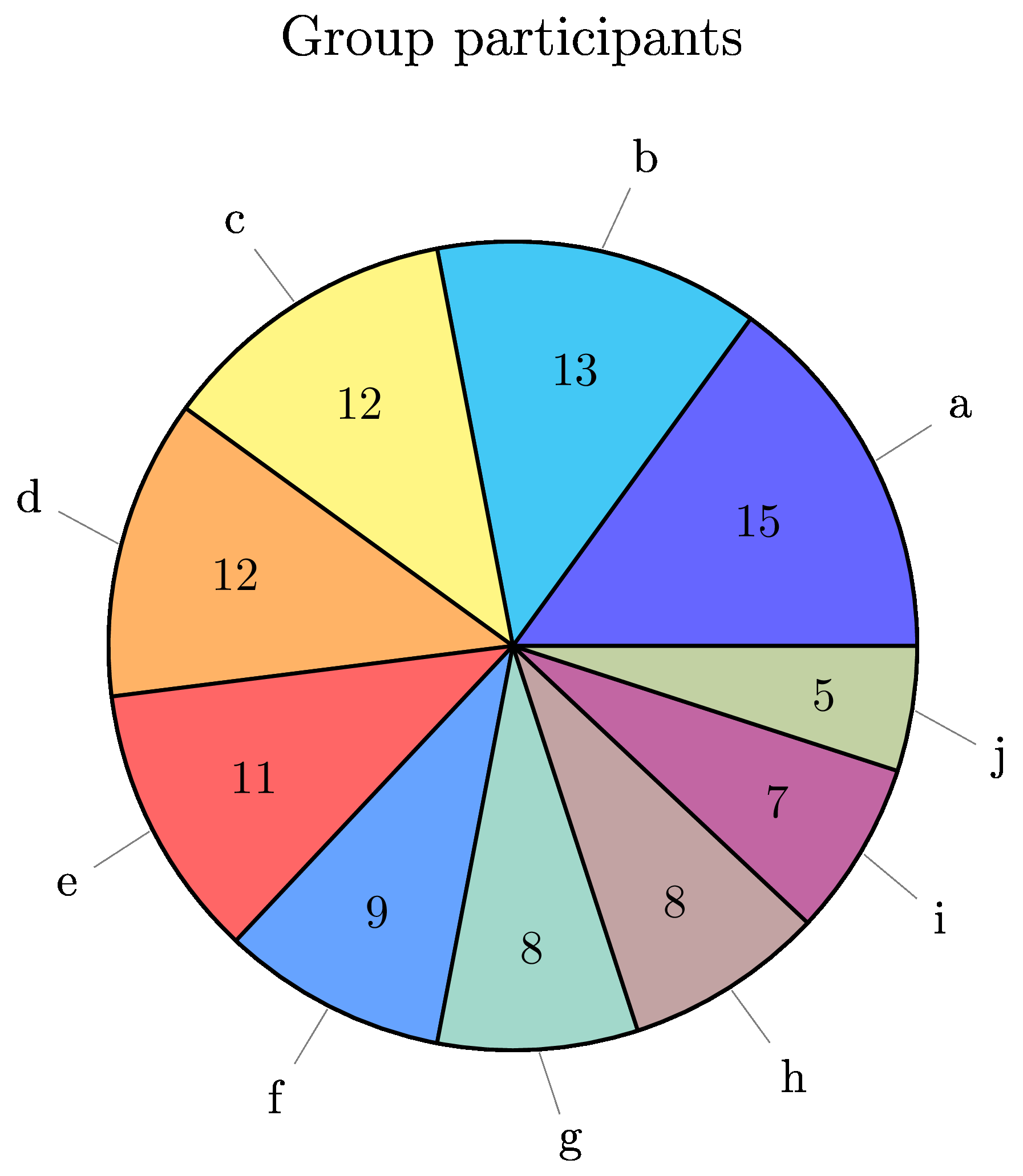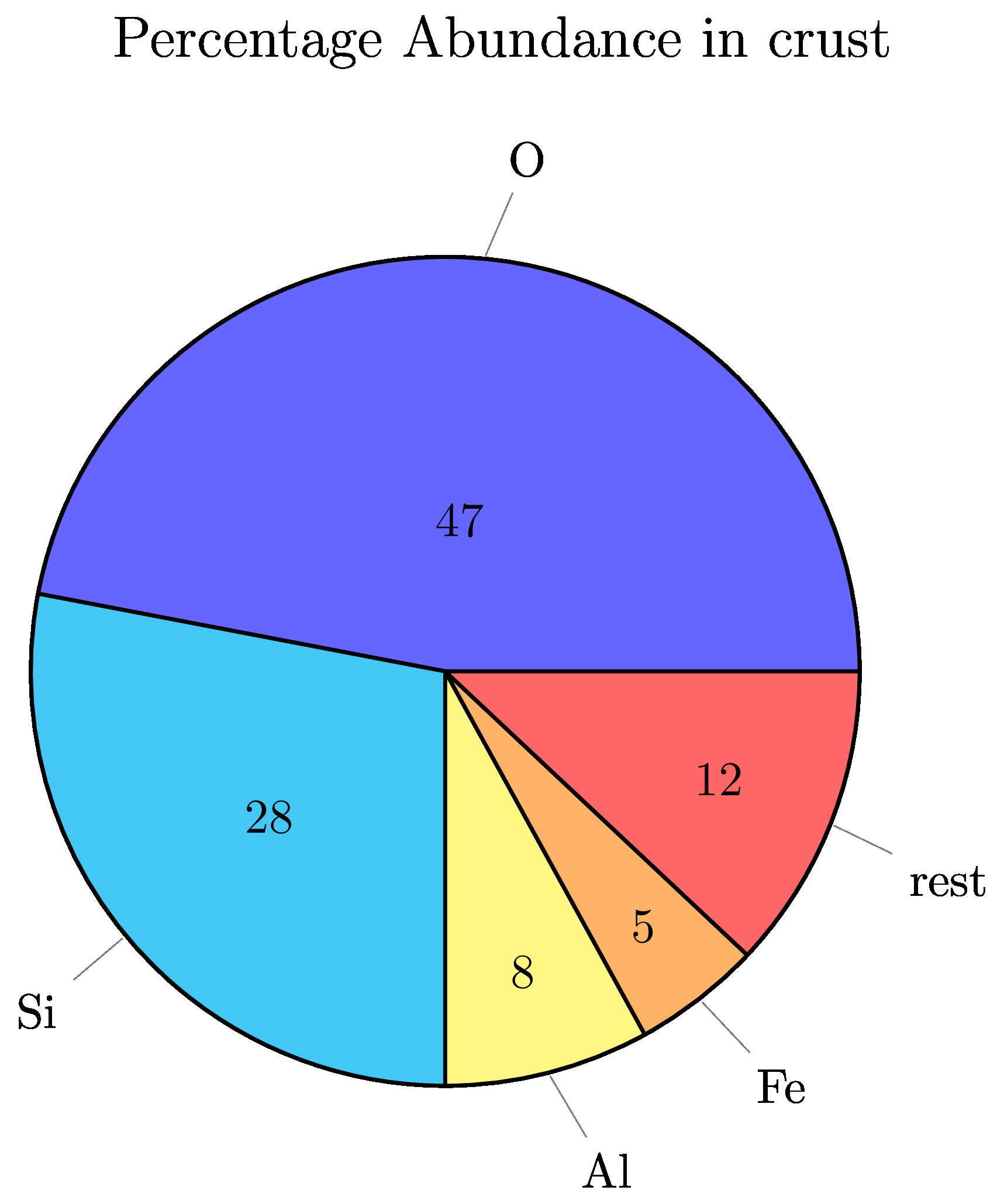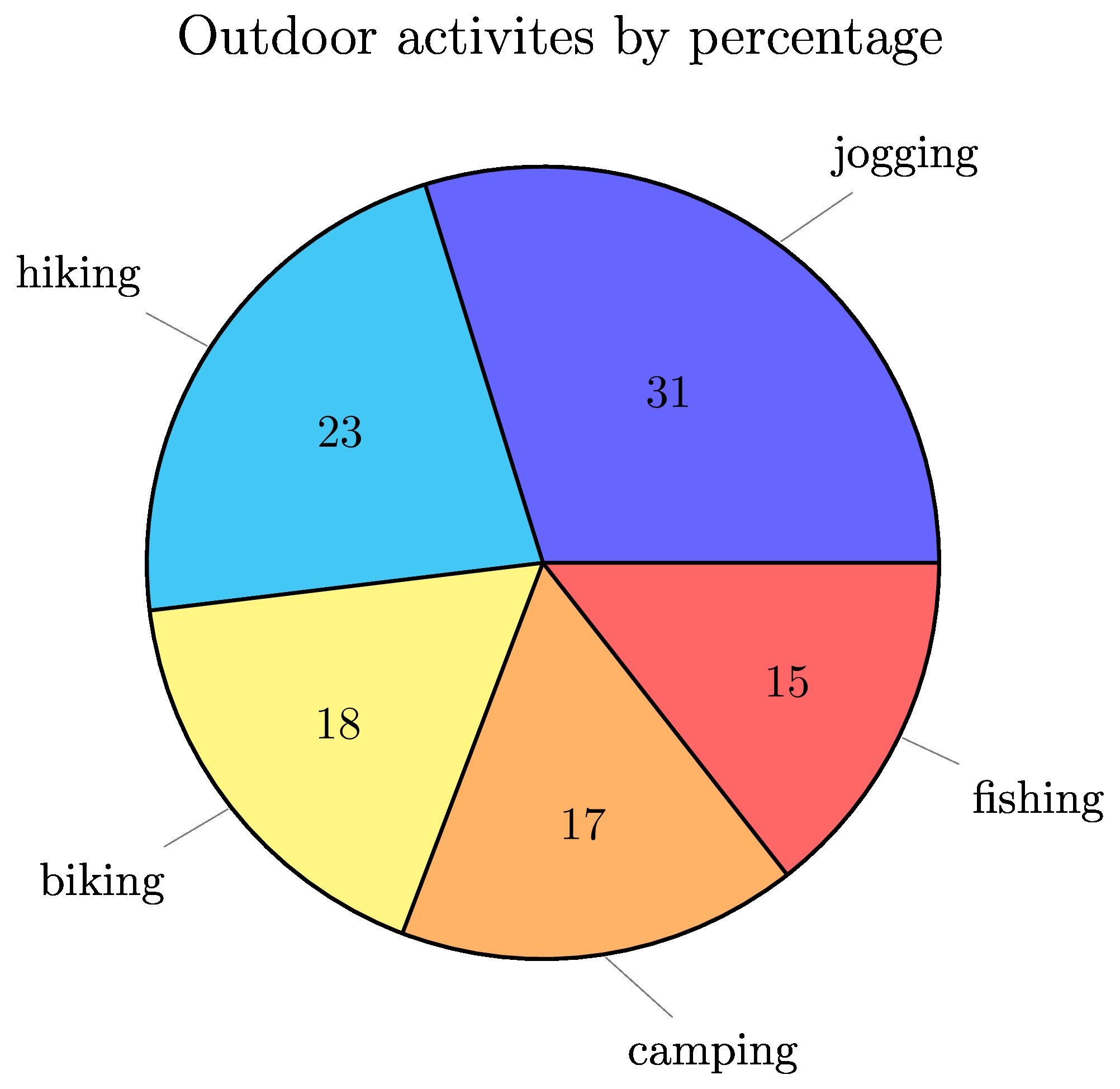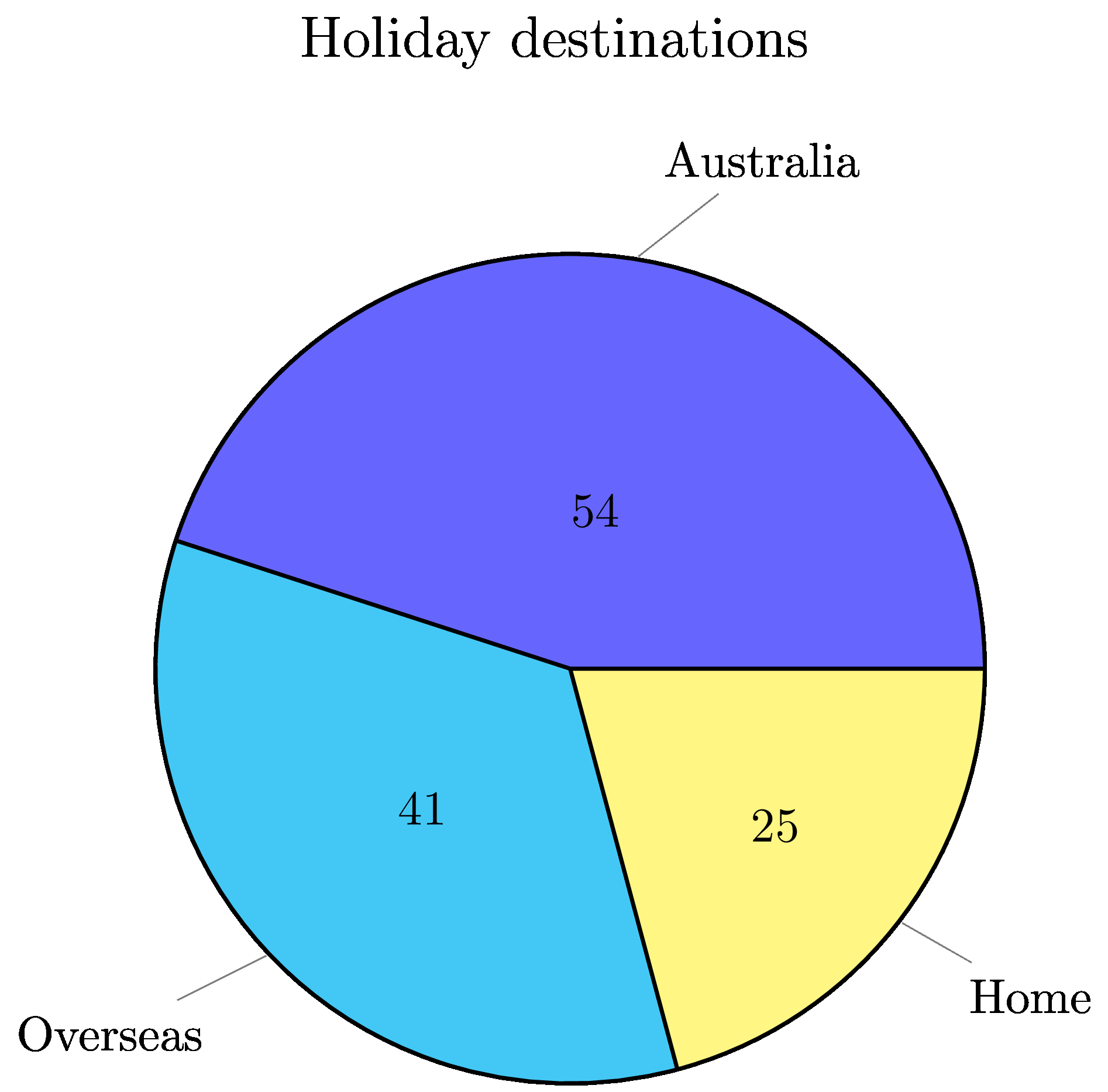5. Pie charts
Pie charts are a bar graph in sections, which often total to 100. (100%)
The python file to make pie charts is below.
The required LaTeX files are below.
The custom python modules required are:
A sample text file is below:
5.1. Example pie charts
5.2. LaTeX
The .tex file template is shown below.
\documentclass{standalone}
\usepackage{pgfplots}
\pgfplotsset{compat=newest}
\usepackage{pgf-pie}
\begin{document}
\begin{tikzpicture}
\pie[text=pin, sum=auto]{
<<data>>
}
\node [above=3mm, font=\large] at (current bounding box.north) {<<title>>};
\end{tikzpicture}
\end{document}
5.3. Txt file
The .txt file is shown below.
3 lines store data:
line 1: the plot title
line 2: a comma separated sequence of numeric values
line 3: a comma separated sequence of double quoted labels for the values
A maximum number of entries for line 2 and line 3 is 10.
Some characters need to be escaped manually such as & for & and % for % if used in line 1 or 3.
Favourite zoo animals
53,50,46,40,38,35,29,25,22,14
monkeys,dolphins,penguins,lions,giraffes,elephants,otters,bears,zebras,hippos
5.4. Png file
The .png file is shown below.
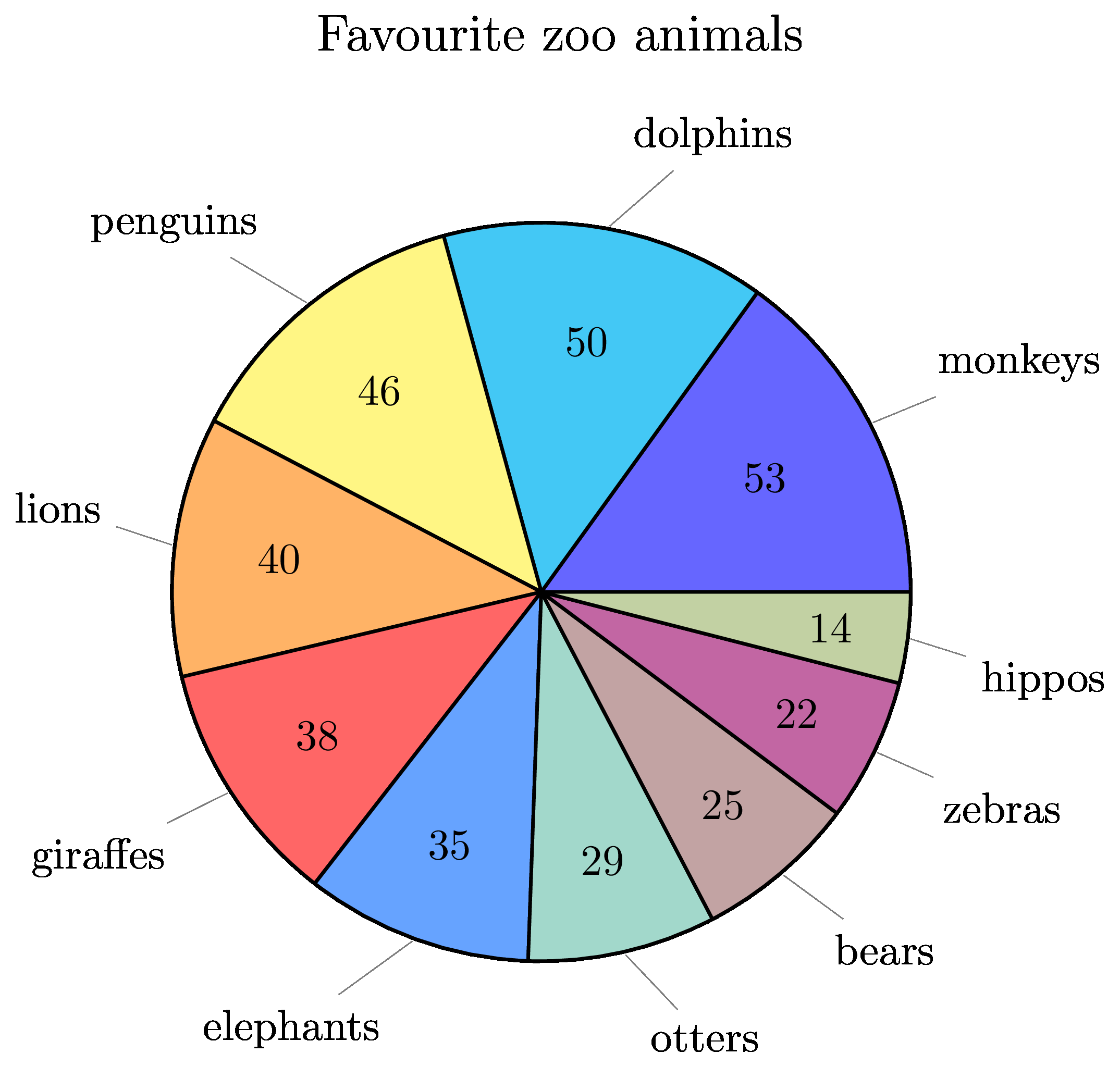
5.5. Python code
The python code is shown below.
from pathlib import Path
import subprocess
from tkinter import filedialog
import time
import magick_pdf_to_png
currfile_dir = Path(__file__).parent
tex_template_path = currfile_dir / "pie_chart_template.tex"
def convert_to_pdf(tex_path, currfile_dir, aux_path):
"""
Converts a TeX file to PDF format using pdfLaTeX.
Args:
tex_path (str): The path to the TeX file.
currfile_dir (str): The path to the directory where the TeX file is located.
aux_path (str): The path to the directory where auxiliary files will be stored.
Returns:
subprocess.CompletedProcess: A subprocess.CompletedProcess object containing information about the completed process.
Raises:
FileNotFoundError: If the TeX file does not exist.
subprocess.CalledProcessError: If pdfLaTeX returns a non-zero exit code.
"""
result = subprocess.run(
[
"pdfLaTeX",
tex_path,
"-output-directory",
currfile_dir,
"-aux-directory",
aux_path,
],
stdout=subprocess.PIPE,
)
def get_list_from_str(data_string):
if ", " in data_string:
data_list = data_string.split(", ")
elif "," in data_string:
data_list = data_string.split(",")
else:
data_list = data_string.split(" ")
return data_list
def get_list_nums_from_str(num_string_list):
have_dec = any("." in s for s in num_string_list)
if have_dec:
num_list = [float(n) for n in num_string_list]
else:
num_list = [int(n) for n in num_string_list]
return num_list
def get_data_string_from_lists(numbers_list, labels_list):
# process numbers_list and labels_list to build 53/monkeys, string
data = ""
for num, label in zip(numbers_list, labels_list):
data += f"{num}/{label},\n"
# strip last 2 chars
return data[:-2]
def get_substrings_from_string(data_string):
new_string = ""
for s in data_string.split(","):
new_string += f'"{s}",'
new_string = new_string[:-1]
return new_string
def get_file_data(filename):
# open the text file and read the numbers
with open(filename) as f:
# read the first line and store it in a variable
title = f.readline().strip()
# read the second line and store it in a variable
numbers_string = f.readline().strip()
# read the third line and store it in a variable
labels_string = f.readline().strip()
#
numbers_list = get_list_from_str(numbers_string)
labels_list = get_list_from_str(labels_string)
# process numbers_list and labels_list to build 53/monkeys, string
data = get_data_string_from_lists(numbers_list, labels_list)
return title, data
def main():
data_filename = filedialog.askopenfilename(initialdir=Path(currfile_dir))
if data_filename == "":
print("Exited, by clicking Cancel")
return
title, data = get_file_data(data_filename)
# Create a Path object from the file path
path_obj = Path(data_filename)
# Get the file name from the Path object using the name attribute
filename = path_obj.stem
# filename = input("Enter the base filename to be added to the prefix dp_: \n")
# if not filename:
# filename = "dp_1"
# set names of files that are made
tex_output_path = currfile_dir / f"{filename}.tex"
pdf_path = currfile_dir / f"{filename}.pdf"
png_path = currfile_dir / f"{filename}.png"
aux_path = currfile_dir / "temp"
# Read in the LaTeX template file
with open(tex_template_path, "r") as infile:
tex_template_txt = infile.read()
# Replace the placeholders in the LaTeX template
tex_template_txt = tex_template_txt.replace("<<title>>", title)
tex_template_txt = tex_template_txt.replace("<<data>>", data)
# Write the question tex to an output file
with open(tex_output_path, "w") as outfile:
outfile.write(tex_template_txt)
# Wait for the files to be created
time.sleep(1)
# Convert the LaTeX files to PDFs
convert_to_pdf(tex_output_path, currfile_dir, aux_path)
# Wait for the files to be created
time.sleep(1)
# Convert the PDFs to PNGs
magick_pdf_to_png.convert_pdf_to_png(pdf_path, png_path)
if __name__ == "__main__":
print("starting")
main()
print("finished")
